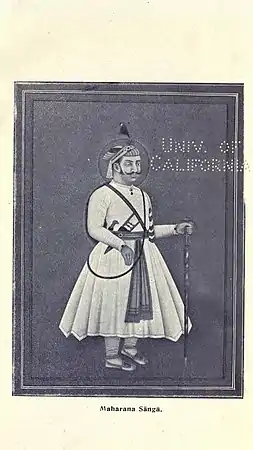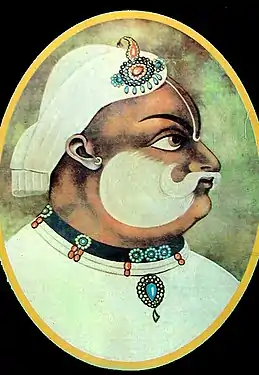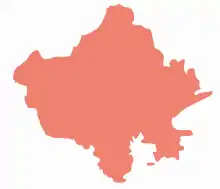History of Rajasthan
The state of Rajasthan in India has a history dating thousands of years. It was the site of the Indus Valley Civilization. The early medieval period saw the rise many Rajput kingdoms like Chauhans of Ajmer, Guhilot and Sisodias of Mewar, Shekhawats of Shekhawati Sikar, Rathores of Marwar. Later the region came under suzerainty of the Mughal Empire. The Mughals granted high positions to Rajput rulers who allied with them. However, some Rajput kingdoms did not accept Mughal suzerainty and were constantly at war with them. The Mughal rule effectively ended in the 18th century, in Rajasthan and Maratha influence grew in the region.
The British made several treaties with rulers of Rajasthan and also made allies out of local rulers, who were allowed to rule their princely states. This period was marked by famines and economic exploitation. However, the British period also saw the growth of railways, telegraph and modern industry in the region. After Indian Independence in 1947, the various princely states of Rajasthan were [[Political integration of India|integrated
Mythology
The written history of Rajasthan is found in the Vedas. It was earlier known as Matsya Janpada as Matsya Avtar was the first incarnation of Lord Vishnu in Virat Nagar, near Jaipur.
The Matsya avtar story is similar to Noah's (Noah; The second Prophet) story. After this In the Ramayana, the Character of Shabri belongs to Virat Nagar as She Married with the king of Virat Nagar, dhe was so beautiful that the king always worried to lose her thus he refused her to go out of home. Once a Kumbha Festival in Prayag (Allahabad U.P.). She demands to go there otherwise she shall attempt suicide. Finally the King was ready, but a condition is she must go early at morning before Sun arises.” She was ready because Kumbha snan (Bathing)- Festival in Prayag happens only once in 12 years. King also went with her to ensure no other man can contact her. When she dipped in River Ganga she weeping out badly The goddess Ganga comes and ask why she was weeping. She replied,’’ Her husband does not allow to go out from home even when she wants to go temple, she needs nothing but only, serve God.” Then Goddess Ganga asked, ”What can I do?”
She requested to Goddess Ganga for converting her to a hackle backed and unattractive so no one can disturb her to praying to God. Goddess Ganga said, “Tathastu “ (same will happen) (Amen). And she converted into a huckle backed and unattractive; and finally became happy and in Ramavtar, Lord Rama Came and ate swat-berry (already tasted). Another discussion about Rajasthan is come in Mahabharat war Pandawa stayed here when they had to live secretly.
Another discussion comes in the time Maurya Chandragupta Mourya beat the Matsya Kingdom. The followers of Matsya Kingdom still live in eastern Rajasthan as called Mina (Matsya is a Sanskrit word means Fish, in local language Meen also means fish ).
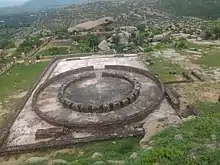
The old Matsya kingdom successor's went to forest, In the Criminal Tribe act they are forced to resettle down and now they belongs to schedule tribe status.
History
The famous Mauryan king Ashoka made a stupa in Virat Nagar. Which had been demolished but remains are still present at the site. After Mauryas, the area came under Shaka and Kushan kingdoms.
The history of human settlement in the west Indian state of Rajasthan dates back to about 5,000 years ago. This region was inhabited during great floods after the ice age as well. This area was known as Rajputana around the time when Kachwaha, a Rajput clan, migrated to the region.[1] The Kachwahas continued to assist their Rajput allies in many Fatal battles including First Battle of Tarain and later in the disastrous Second Battle of Tarain.[2] The last time where Kachwahas fought for Rajputs was under Rana Sanga of Chittor in the Battle of Khanwa.[3]
After the defeat, the Kachwahas accepted the Supremacy of Mughals under the Akbar reign. Although it enhanced their power, the later Kachwahas became infamous in the Rajput history for being the first to accept the supremacy of Turks for which they were taunted by Sissodias of Chittor, who continue to resist Mughals against heavy odds and gave rise to Maharana Pratap who became a symbol of Rajput Valour along with Rana Sanga and Prithviraj Chauhan.[4]
Ancient history
Stone Age tools dating from 5,000 to 2,00,000 years were found in Bundi and Bhilwara districts of the state.[5]
The ancient civilised history of Rajasthan goes back to 5,000 years ago when in the present day districts of Jhunjhunu and Sikar, along with other areas of Jaipur district bordering south Haryana, which formed the part of Vedic state of Brahmavarta along with districts of Mahendragarh and Rewari in Haryana, that Vedic seers started composing Vedic scriptures, which form part of Sanatan Dharma, the base of present-day Hinduism. The revered Saraswati and Drishadwati rivers formed the then Brahmavarta state. Drishadwati river is identified as the Vedic Drishadwati by Bhargava.[6] Parts of Rajasthan may have been occupied by the Indus Valley Civilization (Harappans). Excavations at Kalibanga in northern Rajasthan around 1998 revealed the existence of human settlements of Harappan times on the banks of a river that dried up later, which some people believe to be the Saraswati, archaeologists hope the Saraswati will unlock mysteries of the past. Rajasthan's geographic position in India has caused it to be affected by the expansionist efforts of various empires. It was a part of the Maurya Empire around 321-184 BCE.
Medieval period and Rise of Rajputs
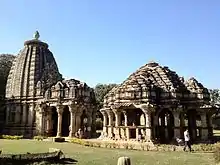
The Gurjar Pratihar Empire acted as a barrier for Arab invaders from the 8th to the 11th century. The chief accomplishment of the Gurjara-Pratihara Empire lies in its successful resistance to foreign invasions from the west, starting in the days of Junaid. Historian R. C. Majumdar says that this was openly acknowledged by the Arab writers. He further notes that historians of India have wondered at the slow progress of Muslim invaders in India, as compared with their rapid advance in other parts of the world. Now there seems little doubt that it was the power of the Gurjara Pratihara army that effectively barred the progress of the Arabs beyond the confines of Sindh, their only conquest for nearly 300 years.[7]
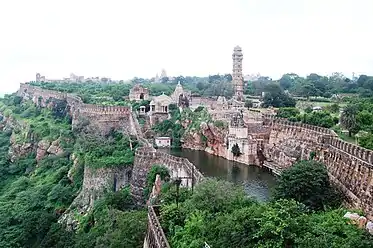
Rajputs Before and After Ghurid Invasions
.jpg.webp) Prithviraj Chauhan a 12th-century Rajput king of Ajmer and Delhi who united several Rajput states and repel a Ghurid Invasion of India in 1191.[9]
Prithviraj Chauhan a 12th-century Rajput king of Ajmer and Delhi who united several Rajput states and repel a Ghurid Invasion of India in 1191.[9]
In the 12th century before Ghurid invasions much of the Indo-Gangetic Plain region were ruled by the Rajputs.[10] In 1191 Rajput king of Ajmer and Delhi Prithviraj Chauhan unified several Rajput states and defeat the invading Ghurid army near Tarain in First Battle of Tarain, however the Rajputs did not chase the Ghurids and let Mu'izz al-Din escape.[11] As a result in 1192 CE, Mu'izz al-Din return with an army of an estimated strength of 120,000 Turks, Afghans and Muslim allies and decisively defeated The Rajput Confederacy at Second Battle of Tarain, Prithviraj fled the battleground but was captured near the battle site and executed. The defeat of Rajputs in the battle begins a new chapter in Rajasthan and Indian history as it not only crush Rajput powers in Indo-Gangetic Plain but also firmly established a Muslim presence in northern India.[12] In the fatal battle Malesi a Kachwaha Rajput and ally of Prithviraj lead the last stand for the Rajputs against Ghurids and died fighting after Prithviraj tried to escape.[13]
Over the next four centuries there were repeated, though unsuccessful, attempts by the central power based in Delhi to subdue the Rajput states of the region. The Rajputs, however, despite common historical and cultural traditions, were never able to unite to inflict a decisive defeat on their opponents.[14]
The Rajputs of Mewar led other kingdoms in its resistance to outside rule. Rana Hammir Singh, defeated the Tughlaq dynasty and recovered a large portion of Rajasthan. The indomitable Rana Kumbha defeated the Sultans of Malwa, Nagaur and Gujarat and made Mewar the most powerful Rajput kingdom in India.
Rajasthan Under Rana Sanga
In 1508 Rana Sanga ascended the throne after a long struggle with his brothers. He was an ambitious king under whom Mewar reached its zenith in power and prosperity. Rajput strength under Rana Sanga reached its zenith and threatened to revive their powers again in Northern India.[16] He establish a strong kingdom from Satluj in Punjab in the north till Narmada River in south in Malwa after conquering Malwa and from Sindhu river in west till Bayana in the east. In his military career he defeated Ibrahim Lodhi at the Battle of Khatoli and manage to free most of Rajasthan along with that he establish his control over parts of Uttar Pradesh including Chandwar, he gave the part of U.P to his allies Rao Manik Chand Chauhan who later supported him in Battle of Khanwa.[17] After that Rana Sanga fought another battle with Ibrahim Lodhi known as Battle of Dholpur where again Rajput confederacy were victorious, this time following his victory Sanga conquered much of the Malwa along with Chanderi and bestowed it to one of his vassal Medini Rai. Rai ruled over Malwa with Chanderi as his capital.[18] Sanga also invaded Gujarat with 50,000 Rajput confederacy joined by his three allies. He plundered the Gujarat sultanate and chased the Muslim army as far as capital Ahmedabad. He successfully annexed northern Gujarat and appointed one of his vassals to rule there. Following the victories over the sultans, he successfully established his sovereignty over Rajasthan, Malwa and large parts of Gujarat.[15] In his campaign of Gujarat the Rajputs destroyed around 200 mosques and burnt down several Muslim towns. According to Chaube the campaign was brutal, in which Rajputs kidnapped many Muslim women as captives and sold them in the markets of Rajasthan.[19] According to Gopinath Sharma the campaign not only enhanced Sanga's fame but also due to the Rajputs' religious bigotry in Gujarat Sanga became a eyesore to Muslim.[20] After these victories, he united several Rajput states from Northern India to expel Babur from India and re-establish Hindu power in Delhi.[21] He advanced with an army of 100,000 Rajputs to expel Babur and to expand his territory by annexing Delhi and Agra.[22] The battle was fought for supremacy of Northern India between Rajputs and Mughals.[23] However Rajput Confederation suffered a disastrous defeat at Khanwa due to Babur's superior leadership and modern tactics. The battle was more historic and eventful than First Battle of Panipat as it firmly established Mughal rule in India while crushing re-emerging Rajput powers. The battle was also earliest to use cannons, matchlocks, swivel guns and mortars to great use.[24]
The battle also marks the last time in medieval India where the Rajputs stood united against a foreign invader. Although the exact casualties are unknown, it is estimated that all Rajput Houses lost many of their close allies in the battle.[3]
Rana Sanga was removed from the battlefield in unconscious state from his vassals Prithviraj Singh I of Jaipur and Maldeo Rathore of Marwar. After regaining consciousness he took an oath to never return to Chittor till he defeat Babur and conquer Delhi. He also stopped wearing a turban and use to wrap up cloth over his head.[25] While he was preparing to wage another war against Babur he was poisoned by his own nobles who opposed another battle with Babur. He died in Kalpi in January 1528.[26]
After his defeat, his vassal Medini Rai was defeated by Babur at the Battle of Chanderi and Babur captured the capital of Rai kingdom Chanderi. Medini was offered Shamsabad instead of Chanderi as it was historically important in conquering Malwa but Rao refuse the offer and choose to die fighting. The Rajput women and children committed Self-immolation to save their honour from the Muslim army. After the victory Babur capture Chanderi along with Malwa which was ruled by Rai.[27] However Babur gave control of Malwa to Ahmed Shah a descendant of Malwa Sultan whose entire Kingdom of Malwa was annexed by Sanga. In this way Babur reinstated Muslim rule in Malwa.[28]
Early Modern period (1526-1858 CE)
Mughal Conquests
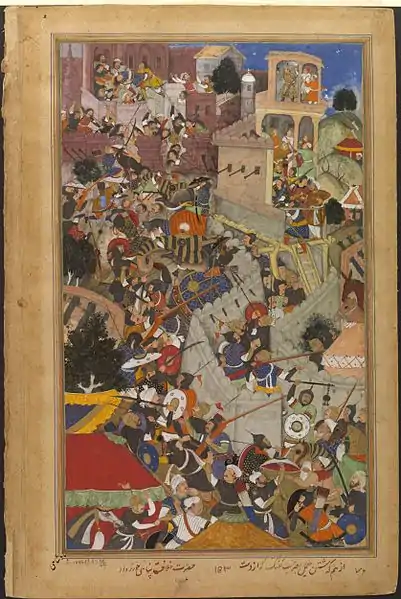
The Mughal Emperor Akbar expanded the empire into Rajputana in the 16th century CE. He laid siege to Chittor and defeated the Kingdom of Mewar in 1568. He also laid siege to Ranthambore and defeated the forces of Surjan Hada in the same year.
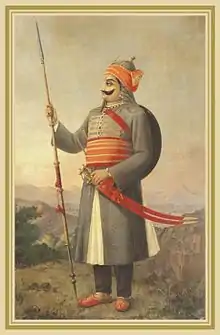
Akbar also arranged matrimonial alliances to gain the trust of Rajput rulers. He himself married the Rajput princess Jodha Bai. He also granted high offices to a large number of Rajput princes, and maintained cordial relations with them, such as Man Singh, one of the navaratnas. However, some Rajput rulers were not ready to accept Akbar's dominance and preferred to remain independent. Two such rulers were Udai Singh of Mewar and Chandrasen Rathore of Marwar. They did not accept Akbar's supremacy and were at constant war with him. This struggle was continued by Rana Pratap, the successor of Udai Singh. His army met with Akbar's forces at the Battle of Haldighati where he was defeated and wounded. Since then he remained in recluse for twelve years and attacked the Mughals from time to time.
Mughal influence is seen in the styles of Rajput painting and Rajput architecture of the medieval period.
Maratha Empire
Since the early 1700s, the Maratha Empire began expanding northwards, led by Peshwa Baji Rao I of Pune. This expansion finally brought the newly founded Maratha Empire in contact with the Rajputs. Rajasthan saw many invasions by the Marathas, under military leadership of Holkars and Scindhias.[30]
British colonial period (1858-1947 CE)
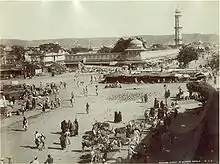
The arrival of the British East India Company in the region led to the administrative designation of some geographically, culturally, economically and historically diverse areas, which had never shared a common political identity, under the name of the Rajputana Agency. This was a significant identifier, being modified later to Rajputana Province and lasting until the renaming to Rajasthan in 1949. The Company officially recognized various entities, although sources disagree concerning the details, and also included Ajmer-Merwara, which was the only area under direct British control. Of these areas, Marwar and Jaipur were the most significant in the early 19th century, although it was Mewar that gained particular attention from James Tod, a Company employee who was enamoured of Rajputana and wrote extensively, if often uncritically, of the people, history and geography of the Agency as a whole.
Alliances were formed between the Company and these various princely and chiefly entities in the early 19th century, accepting British sovereignty in return for local autonomy and protection from the Marathas and Pindari depredations. Following the Mughal tradition and more importantly due to its strategic location Ajmer became a province of British India, while the autonomous Rajput states, the Muslim state of Tonk, and the Jat states of Bharatpur, Dholpur were organized into the Rajputana Agency. In 1817–18, the British Government concluded treaties of alliance with almost all the states of Rajputana. Thus began the British rule over Rajasthan, then called Rajputana.
Post-independence (1947 CE - present)
.jpg.webp)
The name of Rajasthan as Rajputana became more pronounced or Popular in 12th century before Ghurid invasions, also Rajput as a separate caste emerge in Indian social structure around that time in 12th century.[10] The Kachwaha Rajput clan migrated to the region and made Amber their capital in the 12th century and for 600 years continued to be a political centre.[1]
It took seven stages to form Rajasthan as defined today. In March 1948 the Matsya Union consisted of Alwar, Bharatpur, Dhaulpur and Karauli was formed. Also, in March 1948 Banswara, Bundi, Dungarpur, Jhalawar, Kishangarh, Kota, Pratapgarh, Shahpura and Tonk joined the Indian union and formed a part of Rajasthan. In April 1948 Udaipur joined the state and the Maharana of Udaipur was made Rajpramukh. Therefore, in 1948 the merger of south and southeastern states was almost complete. Still retaining their independence from India were Jaipur State and the desert kingdoms of Bikaner, Jodhpur, and Jaisalmer. From a security point of view, it was claimed that it was vital to the new Indian Union to ensure that the desert kingdoms were integrated into the new nation. The princes finally agreed to sign the Instrument of Accession, and the kingdoms of Bikaner, Jodhpur, Jaisalmer and Jaipur acceded in March 1949. This time, the Maharaja of Jaipur, Man Singh II, was made the Rajpramukh of the state and Jaipur became its capital. Later in 1949, the United States of Matsya, comprising the former kingdoms of Bharatpur, Alwar, Karauli and Dholpur, was incorporated into Rajasthan. On January 26, 1950, 18 states of united Rajasthan merged with Sirohi to join the state leaving Abu and Dilwara to remain a part of Greater Bombay and now Gujarat.
Gurumukh Nihal Singh was appointed as first governor of Rajasthan. Hiralal Shastri was the first nominated chief minister of the state, taking office on 7 April 1949. He was succeeded by two other nominated holders of the office before Tika Ram Paliwal became the first elected chief minister from 3 March 1951.
In November 1956, under the provisions of the States Re-organisation Act, the erstwhile part 'C' state of Ajmer, Abu Road Taluka, former part of Sirohi princely state (which were merged in former Bombay), State and Sunel-Tappa region of the former Madhya Bharat merged with Rajasthan and Sironj sub district of Jhalawar was transferred to Madhya Pradesh. Thus giving the existing boundary Rajasthan. Today with further reorganisation of the states of Uttar Pradesh, Madhya Pradesh and Bihar. Rajasthan has become the largest state of the Indian Republic.
The princes of the former kingdoms were constitutionally granted handsome remuneration in the form of privy purses and privileges to assist them in the discharge of their financial obligations. In 1970, Indira Gandhi, who was then the Prime Minister of India, commenced under-takings to discontinue the privy purses, which were abolished in 1971. Many of the former princes still continue to use the title of Maharaja, but the title has little power other than as a status symbol. Many of the Maharajas still hold their palaces and have converted them into profitable hotels, while some have made good in politics. The democratically elected Government runs the state with a chief minister as its executive head and the governor as the head of the state. Currently, including the new district of Pratapgarh, there are 33 districts, 105 sub-divisions, 37,889 villages, 241 tehsils and 222 towns in Rajasthan.
References
Notes
Citations
- Jadunath Sarkar 1994, pp. 22.
- Jadunath Sarkar 1994, pp. 25-27.
- Jadunath Sarkar 1994, pp. 32-33.
- Jadunath Sarkar 1994, pp. 41-42.
- Pillai, Geetha Sunil (28 February 2017), "Stone age tools dating back 2,00,000 years found in Rajasthan", The Times of India
- Sudhir Bhargava, "Location of Brahmavarta and Drishadwati river is important to find earliest alignment of Saraswati river" Seminar, Saraswati river-a perspective, Nov. 20-22, 2009, Kurukshetra University, Kurukshetra, organised by: Saraswati Nadi Shodh Sansthan, Haryana, Seminar Report: pages 114-117
- Radhey Shyam Chaurasia (2002). History of Ancient India: Earliest Times to 1000 A. D. Atlantic Publishers & Distributors. pp. 207–208. ISBN 978-81-269-0027-5.
- Centre, UNESCO World Heritage. "Hill Forts of Rajasthan". UNESCO World Heritage Centre. Retrieved 16 February 2019.
- Jadunath Sarkar 1960, pp. 32-35.
- Jadunath Sarkar 1960, pp. 32.
- Jadunath Sarkar 1994, pp. 25-26.
- Jadunath Sarkar 1960, pp. 37.
- Jadunath Sarkar 1960, p. 32,34.
- History of Rajasthan
- Gopinath Sharma 1954, p. 18.
- History of Rajasthan by Deryck O.Lodrick
- Gopinath Sharma 1954, p. 17.
- Chaurasia 2002, pp. 156-157.
- Chaube 1975, pp. 132-139.
- Gopinath Sharma 1954, pp. 15.
- Gopinath Sharma 1954, p. 19.
- Percival Spear 1990, pp. 23.
- Gopinath Sharma 1954, p. 8.
- Rao 1991, p. 453-454.
- Gopinath Sharma 1954, pp. 43.
- Gopinath Sharma 1954, pp. 44.
- Chaurasia 2002, p. 157.
- Chaurasia 2002, pp. 166-168.
- R.C.Majumdar, H.C.Raychaudhury, Kalikaranjan Datta: An Advanced History of India, fourth edition, 1978, ISBN 0-333-90298-X, Page-535
- Naravane, M. S. (1999). The Rajputs of Rajputana: A Glimpse of Medieval Rajasthan. ISBN 9788176481182. Retrieved 16 March 2014.
Further Reading
- Gupta, R. K.; Bakshi, S. R. (2008), Studies In Indian History: Rajasthan Through The Ages: The Heritage Of Rajputs, 1, Sarup & Sons, ISBN 9788176258418
Primary Sources Bhatnagar, V. S. (1991). Kanhadade Prabandha: India's greatest patriotic saga of medieval times: Padmanābha's epic account of Kānhaḍade. New Delhi: Voice of India.
Bibliography
- Percival Spear (1990). A History of India. Penguin Books India. ISBN 978-0-14-0138368-.
- Jadunath Sarkar (1960). Military History of India. Orient Longmans.
- Jadunath Sarkar (1994). A History of Jaipur: C. 1503-1938. Orient Blackswan. ISBN 978-81-250-0333-5.
- Chaube, J. (1975). History of Gujarat Kingdom, 1458-1537. Munshiram Manoharlal Publishers.
- Gopinath Sharma (1954). Mewar & the Mughal Emperors (1526-1707 A.D.). S.L. Agarwala.
- Rao, K. V. Krishna (1991). Prepare Or Perish: A Study of National Security. Lancer Publishers. ISBN 978-81-7212-001-6.
- Chaurasia, Radhey Shyam (2002). History of Medieval India: From 1000 A.D. to 1707 A.D. Atlantic Publishers & Dist. ISBN 978-81-269-0123-4.
- Sharma, G. N., Bhatnagar, V. S., & University of Rajasthan. (1992). The Historians and sources of history of Rajasthan. Jaipur: Centre for Rajasthan Studies, University of Rajasthan.
